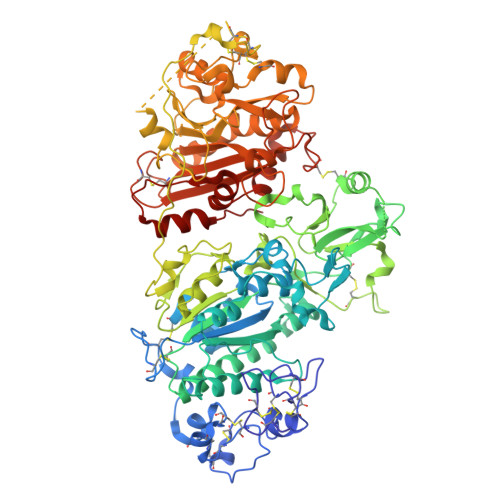Design, Synthesis, and Biological Implications of Autotaxin inhibitors with a Three-Point lock binding mode.
Desroy, N., Borza, R., Heiermann, J., Triballeau, N., Joncour, A., Bienvenu, N., Hengeveld, W.J., Springer, J., Galien, R., Joosten, R.P., Perrakis, A., Heckmann, B.(2025) Bioorg Med Chem 124: 118181-118181
- PubMed: 40233422
- DOI: https://doi.org/10.1016/j.bmc.2025.118181
- Primary Citation of Related Structures:
9FTN, 9FXU, 9FXW, 9FXY - PubMed Abstract:
Autotaxin (ATX) is a circulating enzyme that plays a major role in the production of the signaling mediator lysophosphatidic acid (LPA). A role for ATX/LPA signaling has been described in multiple disease areas, including fibrosis and cancer. ATX inhibitors are classified in five types (I-V) depending on how they target parts of the tripartite site (active site, pocket and tunnel). We set to explore a "penultimate" type of inhibitors, targeting all these three parts at once. Designing new analogs extending on an ethyl group of the type IV GLPG1690 compound, yielded potent new molecules. Co-crystal structures confirmed compounds that utilize a three-point lock binding mode. The most potent "type VI" inhibitors, 4 and 41, displayed increased inhibitory activity (∼40-fold) compared to the type IV close analog 3. Type VI inhibitors 4 and 41 showed cellular and phenotypic activity similar to type IV inhibitor GLPG1690. Identification of this new binding mode completes this combinatorial puzzle in inhibitor design and calls for further investigation to characterize potential therapeutic benefit.
- Galapagos SASU, 102 Avenue Gaston Roussel, 93230 Romainville, France. Electronic address: nicolas.desroy@glpg.com.
Organizational Affiliation:























